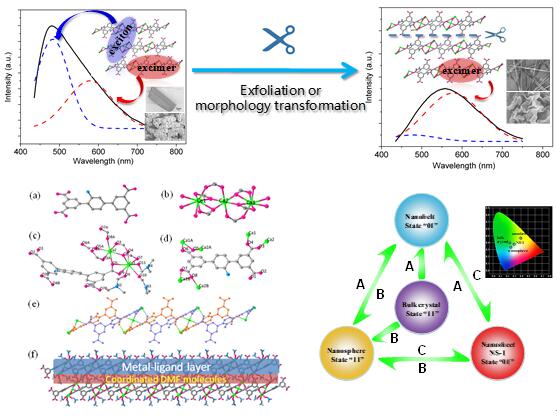Tailoring exciton and excimer emission in an exfoliated ultrathin 2D metal-organic framework
Source: School of Chemistry
Written by: School of Chemistry
Edited by: Wang Dongmei
Two-dimensional (2D) metal–organic frameworks have exhibited a range of fascinating attributes, of interest to numerous fields. Here, a calcium-based metal-organic framework with a 2D layered structure has been designed. Dual emissions relating to intralayer excimers and interlayer trapped excitons are produced, showing excitation-dependent shifting tendency, characteristic of a low dimensional semiconductor nature. Furthermore, the layer stacking by weak van der Waals forces among dynamically coordinated DMF molecules enables exfoliation and morphology transformation, which can be achieved by ultrasound in different ratios of DMF/H2O solvents, or grinding under appropriate humidity conditions, leading to nano samples including ultrathin nanosheets with single or few coordination layers. The cutting down of layer numbers engenders suppression of interlayer exciton-related emission, resulting in modulation of the overall emitting color and optical memory states. This provides a rare prototypical model with switchable dual-channel emissions based on 2DMOFs, in which the interlayer excitation channel can be reversibly tuned on/off by top-down exfoliation and morphology transformation. The present work develops a new concept to synergetically combine bottom-up metal-organic coordination structural design and top-down morphological modification in 2D-MOFs, to achieve new photo-electronic prospects and pave the way for applications in advanced photonic fields.

For detailed information, please read the recently published paper by Professor Mei Pan’s team in the School of Chemistry at Sun Yat-sen University, “Tailoring exciton and excimer emission in an exfoliated ultrathin 2D metal-organic framework” in Nature Communications, doi: 10.1038/s41467-018-04833-1.
Link to the article: www.nature.com/articles/s41467-018-04833-1
